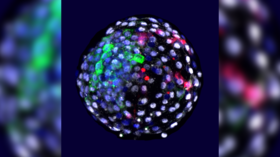Scientists create first chimeric human-monkey embryos which can survive up to 20 days

An international team of scientists based in China and the United States have successfully grown human-monkey chimeric embryos for up to 20 days, a world first, pushing the boundaries of both science and ethics simultaneously.
The research was led by gene expression expert Juan Carlos Izpisua Belmonte from the Salk Institute in California who, along with his team, implanted human stem cells into primate embryos which then grew for up to up to 20 days.
While the ethics of such research will be hotly debated for years to come, the potential benefits with regards to unlocking the remaining secrets of developmental biology and evolution, as well as for the development of new models of human biology and disease, proved significant enough to warrant the risk.
“As we are unable to conduct certain types of experiments in humans, it is essential that we have better models to more accurately study and understand human biology and disease,” says Belmonte.
“An important goal of experimental biology is the development of model systems that allow for the study of human diseases under in vivo conditions.”
The macaque monkey embryos were injected with human extended pluripotent stem cells some six days after they were created. As the name suggests, these stem cells can yield multiple different types of tissue, both embryonic and non- or extra-embryonic tissues.
Also on rt.com Scientists grow first ever HUMAN-MONKEY embryo in ‘promising’ step for organ harvestingThe human cells were detected in 132 of the chimera embryos 24 hours after implantation, while 103 of the chimeric embryos were still developing nine days later.
By day 19, the number of survivors had dropped to three, all of which boasted high percentages of human cells as they continued to grow. All of the embryos were destroyed within 20 days of their creation.
Chimeras have been manufactured since the 1970s, with varying degrees of success. The research is typically done in rodents, but more recently has involved the use of pig and sheep DNA.
The necessary technology that allowed the monkey embryos to survive outside the body for such an extended period of time was developed by Weizhi Ji and his team at Kunming University of Science and Technology in Yunnan, China.
By analyzing the samples, the researchers were able to determine which communication pathways between the monkey and human cells were viable in the generation of future chimeras and which were not.
This will expand the possibility of producing future chimeras with species more genetically distant from humans than monkeys, throwing open the doors to unique research pathways, including growing transplantable organs for use in humans but grown in animals.
Also on rt.com Scientists create human-sheep chimera with hopes of affordable organ transplantsThe researchers were careful to highlight the numerous ethical consultations they engaged in prior to creating the human-monkey chimera embryos and repeatedly underlined their “utmost attention to ethical considerations… by coordinating closely with regulatory agencies.”
Think your friends would be interested? Share this story!













